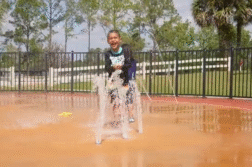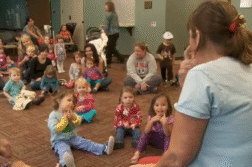BUFFALO, N.Y. (Ivanhoe Newswire) — Mindfulness and meditation techniques are being used in schools across the country. A recent study by the University of California-Davis and the non-profit organization, Mindful Schools, shows mindfulness triples students’ ability to focus and participate in class activities.
It’s not a big deal to see fourth graders meditating and kindergarteners practicing mindful breathing at a mindful elementary school. Every class here has students doing the same thing.
Heidi Palmiero-Potter a 4th Grade Teacher at Harris Hill Elementary School in Buffalo, New York admits students, “They’re less impulsive with each other, they think about their words before they speak so it definitely spills to into the daily routines.”
“Mindfulness can be different things like meditating, deep breathing,” shared 4th grade student, Adam Elbousty
And 3rd grade student, Preston Payne told Ivanhoe meditating is, “Like you breathe really slowly.”
Michelle Braun-Burget, a school psychologist at Harris Hill Elementary School, began testing these techniques three years ago with students.
Braun-Burget said, “What I’m finding is there are a lot of students even at this age, which is K through fifth grade, five year olds to ten, and eleven year olds, who are anxious and nervous and have trouble focusing.”
Braun-Burget mentioned now students are more self-confident.
“They’re just more aware of themselves and what makes them upset, what makes them nervous and they have better control now of how to deal with it,” Braun-Burget shared.
Palmiero-Potter also explained, “If someone’s having a hard time students give them the strategies also. I’ve heard students say do your breathing.”
“The point behind the techniques that mindfulness brings is helping those children learn coping strategies no matter what their circumstances are,” expressed Braun-Burget.
Mindfulschools.org said it has trained teachers in all 50 states and in more than 100 countries so far, impacting more than 750,000 students.
Contributors to this news report include: Kris O’Donnell, Field Producer; Roque Correa, Editor; Tom Vetter, Videographer.
MINDFULNESS IN THE CLASSROOM
REPORT #2397
BACKGROUND: Meditation is an activity where a person learns to focus their attention, and becomes less stressed and calmer. Statistics have shown that people who meditate in groups have seen a decreased crime rate in the area. Furthermore, stress is a risk factor for coronary disease, congestive heart failure, diabetes and high blood pressure. Since meditation reduces stress, meditation also reduces the risk of suffering from these diseases. According to one article, those who meditate can reduce their risk of being hospitalized for a coronary disease by 87%, and reduce the possibility of getting cancer by 55%. Most of the meditation techniques started with Eastern religious or spiritual traditions; but in the present, many of the people who meditate don’t use it for religious or spiritual reasons. Meditation includes:
- Mantra meditation
- Mindfulness meditation
- Spiritual meditation
- Meditation used as part of other practices like yoga, tai chi and qui gong
(Source: https://www.project-meditation.org/a_wim1/statistics_on_people_who_meditate.html & https://nccih.nih.gov/research/statistics/NHIS/2012/mind-body/meditation)
MINDFUL SCHOOLS STUDY: A study conducted by the University of California, Davis, in conjunction with the non-profit organization Mindful Schools, wanted to see how mindfulness meditation affected students. The study involved 937 students and 47 teachers in 3 Oakland school districts. The study was divided into a control group and a mindful group. Those in the mindful group would use the mindful schools’ curriculum that contained the mindful educator essentials; whereas, the control group would only contain 4 hours of mindfulness instructions for the students. The study found statistically significant improvements in the mindful students’ ability to pay attention and participate in class, compared to other students who were in the control group. The educators who participated in the study said they saw in their students:
- 83% improved focus
- 89% better emotional regulation
- 76% more compassion
- 79% improved engagement
(Source: http://www.mindfulschools.org/about-mindfulness/research/)
MINDFULNESS IN EDUCATION & EARLY IN LIFE: Mindfulness meditation in the classroom can help both the teacher and the student. By implementing meditation, teachers benefit from reduced stress and burnout. They perform better in their jobs, have more emotionally-supportive classrooms, and develop better classroom organizations. Students also benefit in their education, as well as their human and personal development. With meditation, they improve in their cognitive outcomes, social-emotional skills, and well-being. These improvements lead to long-term benefits in life. Having good social skills from a small age predicts education, employment, and less crime, substance abuse, and mental health outcomes in adulthood.
(Source: http://www.mindfulschools.org/about-mindfulness/research/)
* For More Information, Contact:
Michelle Braun-Burget
School Psychologist
Clarence Central Schools
Mbraun-burget@clarenceschools.org
Free weekly e-mail on Medical Breakthroughs from Ivanhoe. To sign up: http://www.ivanhoe.com/ftk



